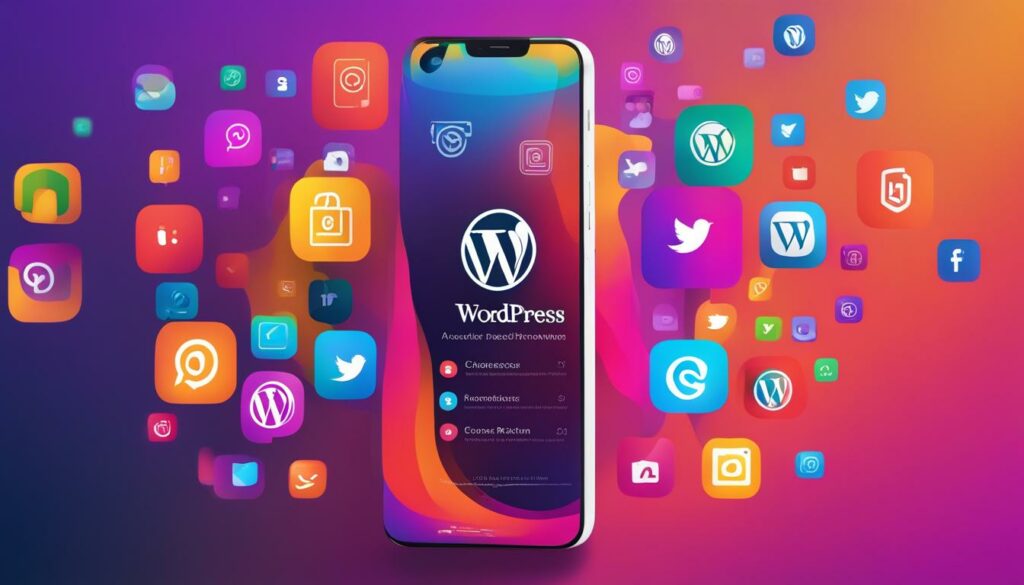Welcome to our in-depth analysis of ensuring accessibility for your WordPress site. In today’s mobile-driven world, it’s essential to optimize your WordPress website for mobile devices to provide a seamless experience for all users. In this section, we will explore some valuable mobile optimization tips specifically tailored to WordPress websites.
With more and more people accessing the internet through their smartphones, having a mobile-friendly website is crucial. Here are some WordPress mobile tips to help you enhance your site’s accessibility:
- Optimize your website for responsive design:
- Use a mobile-friendly WordPress theme that adjusts seamlessly to different screen sizes.
- Ensure your site’s layout and content are user-friendly on mobile devices.
- Compress and optimize images:
- Reduce the file size of images to improve page load speed on mobile devices.
- Use plugins like WP Smush or EWWW Image Optimizer to automatically optimize images.
- Enable caching:
- Utilize caching plugins to improve website performance and reduce load times.
- Implement browser caching to store temporary versions of your web pages for quicker access.
- Minify CSS and JavaScript files:
- Minimize the size of your CSS and JavaScript files to improve load times.
- Utilize plugins like Autoptimize or WP Super Minify to automatically combine and minify these files.
- Test your website on different devices:
- Ensure your website renders correctly and functions properly across various mobile devices and screen sizes.
- Use tools like Google’s Mobile-Friendly Test to identify any issues and make necessary optimizations.
Key Takeaways:
- Optimize your WordPress website for mobile devices to improve accessibility.
- Choose a mobile-friendly WordPress theme and ensure your site’s layout and content are user-friendly on mobile devices.
- Compress and optimize images to improve page load speed on mobile devices.
- Enable caching and minify CSS and JavaScript files to improve website performance on mobile.
- Test your website on different devices to ensure proper functionality and rendering.
Is WordPress Accessibility-Ready?
WordPress is committed to promoting accessibility in its core software and expects developers contributing to the core or creating plugins/themes to adhere to the Web Content Accessibility Guidelines (WCAG) 2.1. However, it’s important to note that not all themes labeled as “Accessibility Ready” meet AA compliance. The responsibility for WordPress accessibility lies with website owners, who need to ensure that their websites are accessible to all users.
WordPress.org provides specific accessibility guidelines that website owners should follow. This includes using accessibility-ready themes and plugins that comply with WCAG 2.1 standards. Adhering to coding standards plays a crucial role in ensuring WordPress accessibility, as it ensures that the code is structured in an accessible manner.
“Just as builders must construct accessible entrance ramps into buildings, WordPress users must create accessible websites.”
The Role of Accessibility-Ready Themes
Accessibility-ready themes are designed with accessibility in mind and have undergone rigorous testing to ensure they meet WCAG 2.1 standards. Choosing an accessibility-ready theme is an effective way to start building an accessible WordPress website. These themes typically include features and design elements that make it easier for users with disabilities to access and navigate the site.
Accessibility-ready themes often incorporate features such as:
- Properly structured headings for screen readers
- Clear color contrasts for better visibility
- Keyboard navigation compatibility
- Alternative text for images
Using an accessibility-ready theme as a foundation can significantly reduce the amount of work required to make a website accessible.
The Importance of Accessibility in WordPress
Ensuring WordPress accessibility is crucial as it promotes inclusivity and allows people with disabilities to access and interact with websites effectively. By making your WordPress site accessible, you are opening up your content and services to a wider audience.
Moreover, accessibility is not only a moral obligation but also a legal requirement in many countries. Failure to comply with accessibility standards can lead to legal consequences, including potential lawsuits and costly penalties.
WCAG 2.1 Standards
WCAG 2.1 is the most widely accepted set of guidelines for web accessibility. It provides a comprehensive framework for making websites accessible to individuals with disabilities. By complying with WCAG 2.1, you ensure that your WordPress website meets the necessary accessibility standards.
WCAG 2.1 covers various aspects of accessibility, including:
| Element | Description |
|---|---|
| Perceivability | Ensuring that information and user interface components can be perceived by all users |
| Operability | Making web content and navigation easily operable for all users |
| Understandability | Providing clear and straightforward information and operation |
| Robustness | Ensuring websites are compatible with various devices and assistive technologies |
Meeting these guidelines is crucial for creating an inclusive online environment.
“Web accessibility is not just about complying with the law; it’s about embracing inclusivity and ensuring equal access to information for everyone.”
The Importance of WordPress Accessibility
More than a billion people around the world have disabilities. Ensuring WordPress accessibility is crucial to providing equal access to information and services for all users. Furthermore, accessibility promotes better design practices, focusing on simplicity and clarity.
Accessibility is not only important for users with disabilities but for everyone. When you implement accessible design practices, you enhance the user experience for all visitors to your website. Clear navigation, readable content, and intuitive interfaces benefit everyone.
In addition to improving user experience, accessibility has become a Google ranking signal. Search engines prioritize websites that are accessible and user-friendly. By optimizing your WordPress site for accessibility, you can potentially boost your search engine rankings and increase organic traffic.
Furthermore, neglecting accessibility can have serious consequences, including legal repercussions. Non-compliance with accessibility regulations can result in lawsuits and damage to your brand’s reputation. It’s essential to prioritize accessibility in your website development process.
“Accessibility involves more than just making accommodations for people with disabilities. It’s about creating an inclusive and user-friendly web environment for all.”
By making your WordPress website accessible, you not only cater to a wider audience but also align with inclusive design principles. Accessibility is a fundamental right, and it’s our social responsibility to promote equal access to digital content.
Key Takeaways:
- WordPress accessibility is crucial for providing equal access to information and services for people with disabilities.
- Accessible design practices enhance the user experience for all visitors.
- Google considers accessibility as a ranking signal, potentially impacting your search engine rankings.
- Non-compliance with accessibility regulations can result in legal consequences and damage to your brand’s reputation.
| Accessibility Benefits | Implications of Neglecting Accessibility |
|---|---|
| Improved user experience for all visitors | Potential lawsuits and legal consequences |
| Better search engine rankings | Damage to brand reputation |
| Increased website traffic and engagement | Exclusion of a significant user demographic |

Implementing accessible design practices benefits everyone and is essential in creating a more inclusive online environment. By ensuring accessibility for your WordPress website, you open doors to a wider audience, improve user experience, and foster inclusivity in the digital space.
Key Elements of Web Accessibility
Web accessibility plays a vital role in ensuring that your website can be accessed and used by all individuals, regardless of their abilities. It consists of four essential elements that work together to create an inclusive online experience.
1. Perceivability
Perceivability focuses on making sure that information and user interface components are perceivable to all users, including those with visual or hearing impairments. This involves providing alternatives for non-text content, such as images and videos, through descriptive text or captions.
2. Operability
Operability ensures that web content and navigation are easy to use by people with various disabilities. This includes enabling keyboard accessibility for individuals who cannot use a mouse, providing clear and consistent navigation options, and allowing users to easily pause, stop, or control any moving or auto-updating content.
3. Understandability
Understandability focuses on presenting information and operation in a clear and straightforward manner. This includes using plain language, organizing content in a logical manner, and providing instructions or cues that help users navigate and interact with your website effectively.
4. Robustness
Robustness ensures that your website is compatible with different devices and assistive technologies, such as screen readers and braille displays. This involves using standard web technologies, adhering to coding best practices, and providing proper semantic structure to enhance compatibility and usability.
By incorporating these key elements of web accessibility into your website design and development process, you can create an inclusive online environment that benefits all users. Now let’s explore some common misconceptions about WordPress website accessibility in the next section.
Myths About WordPress Website Accessibility
Despite the growing awareness and efforts to improve web accessibility, there are still some misconceptions regarding WordPress accessibility. Let’s debunk these myths and shed light on the truth.
Myth 1: Accessibility Only Applies to Visually Impaired People
Fact: Accessibility encompasses a wide range of disabilities, including visual, auditory, motor, and cognitive impairments. It ensures that people of all abilities can access and navigate websites easily. By making your WordPress site accessible, you create an inclusive online environment for everyone.
Myth 2: Installing a Plugin Makes Your Site Accessible
Fact: While plugins can enhance certain accessibility features, they do not guarantee full accessibility. Plugins may have limitations, and relying solely on them can leave gaps in accessibility. It’s essential to adopt a holistic approach to accessibility, considering all aspects of your WordPress site’s design, development, and content.
Myth 3: Web Accessibility is Just a Passing Trend
Fact: Web accessibility is not a temporary trend; it is a human right. As digital technology becomes increasingly integrated into our lives, equitable access to online information and services is essential. Investing in accessibility benefits both users and website owners, ensuring equal opportunities and a better user experience for all.
Myth 4: Accessibility Is Too Complex and Burdensome
Fact: While accessibility may seem daunting at first, there are established guidelines and best practices available to help you navigate the process. Organizations such as the W3C (World Wide Web Consortium) and the WAI (Web Accessibility Initiative) provide valuable resources, including the WCAG (Web Content Accessibility Guidelines), to assist you in achieving accessibility on your WordPress site.
By debunking these myths, we can pave the way for a more accessible digital landscape. Let’s embrace the principles of web accessibility and work towards creating inclusive online experiences for all users.
Why You Should Make WordPress Accessible
Making your WordPress website accessible is not just a social responsibility, but it also brings numerous benefits. By ensuring that your website is accessible to all users, you expand your reach to a wider audience, improve your SEO rankings, enhance user experience, and ultimately enhance your brand’s reputation.
“Creating an inclusive online environment through accessibility is not only the right thing to do but also a smart business move.”
With accessibility, you open your virtual doors to millions of individuals who have different abilities and disabilities. By catering to their needs, you tap into a diverse market that can significantly expand your customer base. Accessibility allows your website to be inclusive, ensuring that all users can navigate, consume content, and engage with your brand effectively.
Moreover, when your WordPress website meets accessibility standards, it positively impacts your SEO rankings. Search engines value websites that provide a better user experience, which accessibility contributes to. By optimizing accessibility, you’re sending signals to search engines that your website is user-friendly and inclusive, leading to higher rankings in search results.
User experience is a critical factor in website success. When you prioritize accessibility and remove barriers for individuals with disabilities, you create a seamless and intuitive experience for all users. An accessible website will have intuitive navigation, readable content, and clear calls-to-action, making it easier for users to achieve their objectives. This not only improves user satisfaction but also increases conversions and customer loyalty.
Furthermore, making your WordPress website accessible demonstrates your commitment to inclusivity and social responsibility. This can enhance your brand’s reputation and strengthen your customer relationships. When users perceive your brand as accessible and accommodating, they are more likely to engage positively with your content, products, and services. Additionally, providing equal access to information and services can lead to positive word-of-mouth recommendations, boosting your brand’s visibility and credibility.
Key Benefits of Making WordPress Accessible:
- Expand your audience reach to individuals with disabilities
- Improve your SEO rankings by signaling a better user experience
- Enhance user experience for all visitors
- Boost your brand’s reputation and credibility
Overall, investing in WordPress accessibility is a win-win situation. You not only ensure that your website is accessible to all users but also reap the rewards of a wider audience reach, improved SEO rankings, better user experience, and an enhanced brand reputation.
Tips to Optimize WordPress Accessibility
When it comes to optimizing WordPress accessibility, there are several key strategies you can implement. By adhering to industry guidelines and taking advantage of the right tools and features, you can ensure that your website is accessible to all users. Here are some essential tips to help you optimize WordPress accessibility:
- Familiarize yourself with W3C, WAI, and WCAG guidelines: These guidelines provide valuable insights into best practices for web accessibility. By understanding and following these standards, you can ensure your website meets the necessary accessibility requirements.
- Use an accessibility-ready theme: Opt for a WordPress theme that is specifically designed to be accessible. These themes typically follow WCAG guidelines and prioritize accessibility features, making it easier for you to create an inclusive website.
- Install accessibility plugins: Take advantage of WordPress accessibility plugins that offer additional features and functionality to improve accessibility. These plugins can help with tasks such as adding alternative text for images, creating accessible forms, and enhancing keyboard navigation.
- Ensure your code is accessible: When developing or customizing your WordPress website, make sure your code is structured in an accessible manner. Follow best practices for semantic HTML, proper use of headings, and appropriate labeling of form elements.
- Use captions for images and videos: Including captions for images and videos ensures that users with visual impairments or who are unable to view multimedia content can still understand the context. This can be achieved by adding descriptive alt text for images and providing closed captions or transcripts for videos.
- Make your site keyboard navigable: Keyboard navigation is crucial for users who rely on assistive technologies such as screen readers or alternative input devices. Ensure all interactive elements and navigation can be accessed and operated using a keyboard alone.
- Choose accessible colors and fonts: Select color combinations that offer sufficient contrast and readability. Use fonts that are clear and easily readable across different devices and screen sizes. Avoid using color or font styles that may be difficult to perceive or understand.
- Create accessible content: When creating content for your WordPress website, keep accessibility in mind. Use clear and concise language, provide descriptive headings, and structure your content in a logical manner. Further, ensure that all media elements are accessible and can be easily understood by all users.
- Avoid auto-playing videos: Auto-playing videos can be disruptive and disorienting for some users. Provide controls that allow users to choose whether they want to play the video. This gives users more control over their browsing experience and helps improve accessibility.
By implementing these tips, you can optimize WordPress accessibility and create a more inclusive and user-friendly website for all visitors.

| Plugin Name | Features | Compatibility | Price |
|---|---|---|---|
| 1. WP Accessibility | Allows customization of accessibility features, such as skip links and text resizing | Compatible with most WordPress themes and plugins | Free |
| 2. Accessible360 | Provides automated scans and accessibility reports | Works with most WordPress sites | Paid |
| 3. UserWay | Offers accessibility toolbar, font resizing, and keyboard navigation enhancements | Compatible with popular themes and plugins | Freemium |
| 4. Accessibility by Woorank | Provides SEO and accessibility audits, as well as monitoring and reporting | Compatible with WordPress and other CMS platforms | Paid |
| 5. WP Accessibility Helper | Enables users to customize accessibility settings based on individual needs | Compatible with most WordPress websites | Free |
TL;DR: Summary of WordPress Accessibility Optimization
Optimizing WordPress accessibility is crucial to ensure an inclusive web design that benefits all users. By following guidelines, using accessibility-ready themes and plugins, creating accessible content, and regularly testing your site for accessibility, you can enhance the user experience and make your website accessible to a wider audience.
Familiarize Yourself with Guidelines
Begin by familiarizing yourself with accessibility guidelines such as the Web Content Accessibility Guidelines (WCAG). These guidelines provide detailed information on how to make your website accessible and provide a roadmap for optimization.
Use Accessibility-Ready Themes and Plugins
Choose WordPress themes and plugins that are labeled as “Accessibility Ready.” These themes and plugins are designed with accessibility in mind and follow the necessary coding standards to ensure an inclusive user experience.
Ensure Accessible Code
Optimize your website’s code for accessibility by adhering to coding standards and best practices. Use semantic HTML tags, provide alternative text for images, and ensure proper headings and link structure.
Provide Captions and Keyboard Navigation
Make your website more accessible by providing captions for images and videos. This helps users with visual impairments understand the content. Additionally, ensure that your website can be navigated using a keyboard, allowing users who rely on keyboard navigation to access all the interactive elements.
Choose Accessible Colors and Fonts
Select colors and fonts that are easy to read and have sufficient contrast. This ensures that the content is legible for users with visual impairments or those viewing your website in different environments.
Create Accessible Content
Craft your website’s content in a way that is accessible to all users. Use clear and concise language, avoid jargon, and structure your content using headings and lists for better readability.
Regularly Test for Accessibility
Regularly test your website for accessibility using automated tools and assistive technologies. This will help identify any accessibility issues and allow you to make necessary improvements.
| Optimization Steps | Impact |
|---|---|
| Familiarize Yourself with Guidelines | Provides a foundation for accessibility optimization |
| Use Accessibility-Ready Themes and Plugins | Ensures your website is built with accessibility in mind |
| Ensure Accessible Code | Makes your website more accessible to assistive technologies |
| Provide Captions and Keyboard Navigation | Enhances accessibility for users with visual and motor impairments |
| Choose Accessible Colors and Fonts | Improves readability for all users |
| Create Accessible Content | Makes information more accessible to all users |
| Regularly Test for Accessibility | Ensures ongoing accessibility and identifies any issues |

By optimizing WordPress accessibility, you can create an inclusive web design that caters to the diverse needs of your users. Implementing these optimization strategies will not only improve the user experience but also enhance your brand reputation and demonstrate your commitment to inclusivity.
Conclusion
Web accessibility is crucial for creating an inclusive online space. By optimizing WordPress accessibility, you can ensure equal access to information and services for all users. It improves user experience, search engine rankings, and brand reputation. Implementing accessibility best practices promotes a more accessible and user-friendly web environment. Embrace diversity and prioritize inclusivity in web design.
FAQ
Q: What is the importance of WordPress accessibility?
A: Ensuring WordPress accessibility allows equal access to information and services for all users, improves user experience, enhances SEO rankings, and boosts brand reputation.
Q: Does WordPress have built-in accessibility features?
A: WordPress strives for accessibility, but not all themes and plugins labeled as “Accessibility Ready” meet AA compliance. The responsibility for accessibility lies with website owners.
Q: What are the key elements of web accessibility?
A: Web accessibility includes perceivability, operability, understandability, and robustness. These elements ensure that information and user interface components can be perceived, web content and navigation are easy to use, information is clear and straightforward, and websites are compatible with various devices and assistive technologies.
Q: What are some common myths about WordPress website accessibility?
A: Common misconceptions include thinking that accessibility only pertains to visually impaired individuals, believing that installing a plugin automatically makes a site accessible, and considering web accessibility as a passing trend rather than a human right.
Q: Why should I make my WordPress site accessible?
A: Making your WordPress site accessible opens it up to a wider audience, improves SEO rankings, enhances user experience, and boosts your brand’s reputation. Additionally, accessibility is a social responsibility and can lead to positive word-of-mouth recommendations.
Q: What are some tips to optimize WordPress accessibility?
A: To optimize WordPress accessibility, follow W3C, WAI, and WCAG guidelines, use an accessibility-ready theme, install accessibility plugins, ensure your code is accessible, use captions for images and videos, make your site keyboard navigable, choose accessible colors and fonts, create accessible content, and avoid auto-playing videos.
Q: Can you summarize the steps for optimizing WordPress accessibility?
A: To optimize WordPress accessibility, familiarize yourself with guidelines, use accessibility-ready themes and plugins, ensure accessible code, provide captions and keyboard navigation, choose accessible colors and fonts, create accessible content, and regularly test your site for accessibility.
Q: Why is web accessibility important?
A: Web accessibility is crucial for creating an inclusive online space. It ensures equal access to information and services for people with disabilities and promotes a more accessible and user-friendly web environment.












